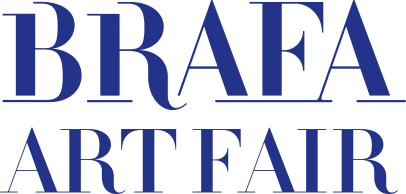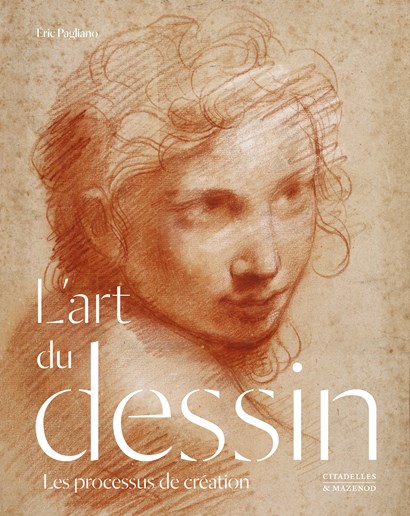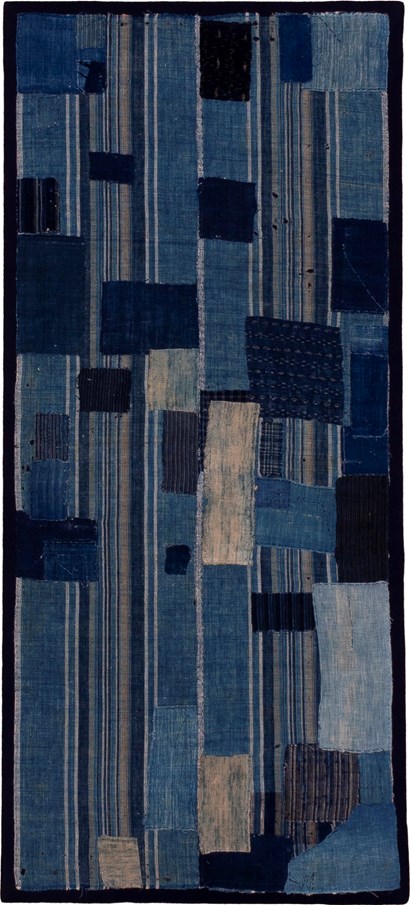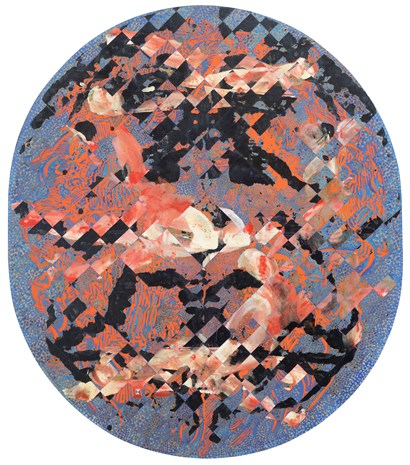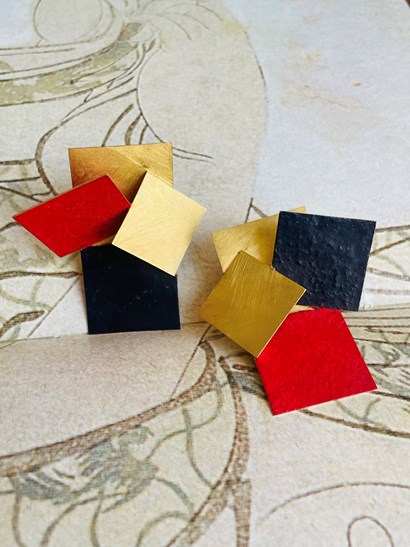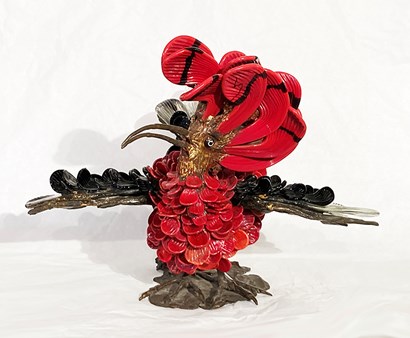This section will be available this Autumn.
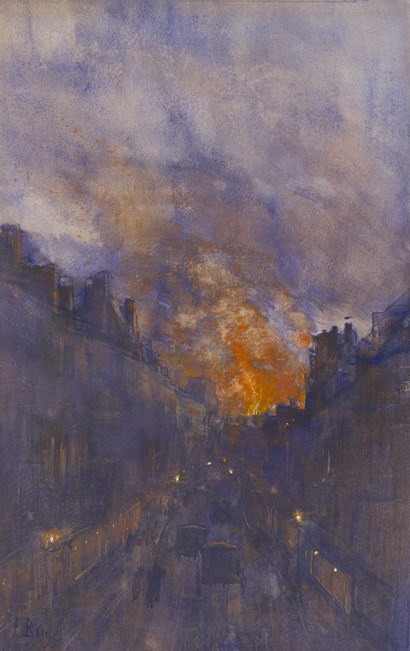
Thomas Deprez Fine Arts
franz binjé
Franz Binjé (Liège 1835-1900 Brussels) Le feu, circa 1894 Watercolour and gouache on paper 42 x 27.5 cm Signed l.l.: 'F. Binjé'. Provenance: private collection, Belgium Exhibitions: Exposition Universelle des Beaux-Arts, section Société Royale belge des Aquarellistes, Antwerp, World Fair, 1894, cat. nr. 699, as: 'Le feu'; Internationale Kunst-Ausstellung, Berlin, World Fair, 1896, Gemälde cat. nr. 228, as: 'Das Feuer. Aquarell.'

Serge Schoffel - Art Premier
Sitting male figure Timoto-Cuica, 900-1300 AD Trujillo State, Venezuela Terracotta, pigments H 29 x W 23 x D 17.5 cm Datation: TL test n° 481z12 by the Research Laboratory for Archaeology, Oxford University, United Kingdom, on 7 May 1991 Provenance: Galerie Ferrero, Geneva, 1968; collection Barbier-Mueller, Geneva, Inv. n° 530-2; Sotheby's auction, Paris, collection Barbier-Mueller-Art Précolombien, on 22 and 23 March 2013, n° 265 Literature: Paz, Octavio, Butor, Michel, Barbier, Jean-Paul, Stierlin, Henri, Lavallée, Danièle, Conceição G., Corrêa, Barry, Iris, 1992, Art millénaire des Amériques : de la découverte à l'admiration, 1492-1992, Arthaud, fig. 130, p. 178 & 179; Conceição G., Corrêa, Barry, Iris, 2002, Amazonie précolombienne, Museo Barbier-Mueller de Arte Precolombino, Barcelona, 5 Continents, fig. 4, p. 17; Benson, Elizabeth P., 2003, Trésors de la céramique précolombienne du Museo Barbier-Mueller de Arte Precolombino de Barcelona, Musée Barbier-Mueller et Somogy éditions d’art, fig. 44, p. 52

Gallery de Potter d’Indoye
Mantel clock depicting the fall of Phaeton Ormoulu bronze France, Consulat period, circa 1800 H 80 x W 53 x D 19 cm Provenance: collection of Robert de Balkany, Paris Literature: Hans Ottomeyer and Peter Pröschel, Vergoldete Bronzen, Munich, 1986, pp. 354-355, n° 5.9.4.; Marie-France Dupuis-Baylet, L’Heure, le Feu, la Lumière, les Bronzes du Mobilier National 1800-1870, 2010, Ed. Faton, p. 26 n° 1; Marie-France Dupuy-Baylet, Napoléon 1er et les Arts décoratifs. Trésors des palais impériaux, exh. cat. 2013, Macao, Museum of Art, n° 1, pp. 34-35; Thierry Sarmant, Palais disparus de Napoléon : Tuileries, Saint-Cloud, Meudon [exhibition, Paris, Galerie des Gobelins, 15 September 2021 to 15 January 2022], Paris : In fine, 2021; Adrien Goetz, Ambroise Tézenas, Résidences présidentielles, Paris : Flammarion, 2021, p.173 The subject of this clock illustrates the episode in which Jupiter strikes Phaeton with a thunderbolt. Phaeton wanted proof that he was the son of the Sun, (Helios). Phaeton then asked his father to let him drive his chariot. Terrified by the height and the sky, Phaeton veered off course and descended so low that he scorched the Earth. The maddened stars complained to Jupiter, who struck the chariot and Phaeton. 'The terrified horses leap in a large circular movement with pin-wheel escapement mounted on the backplate, the pendulum crutch with fine-screw beat adjustment, and outside countwheel strike on a bell, the canthmechanism showing seconds with original hands'. The bronzier Pierre-Etienne Romain (1765- after 1821) deposited the drawing of a Clock representing the same subject in the cabinet of drawings of the National Library in March 1800. Related works: The Mobilier National keeps three clocks representing this subject: one found at the Tuileries Palace in 1809, another at Ministry of Foreign Affairs, and the third at the Palace of Saint Cloud in 1818, then at the Elysée Palace.

Galerie Flak
Hemba ancestor figure Singiti (commemorative portrait of a chief) Democratic Republic of Congo-Upper Congo River 19th century or early 20th century Carved wood H 86.5 cm Provenance: Mia van Bussel collection, Amsterdam; Kevin Conru collection, Brussels; Adrian Schlag collection, Brussels; Guilhem Montagut collection, Barcelona Literature: Lexikon der Afrikanischen Kunst, Karl-Ferdinand Schaedler, Munich, 1994, p. 242

Vagabond Antiques
Monumental carved marble Sundial Portugal, Oporto region, mid-18th century H 357 x W 130 x D 62 cm Portugal has a rich tradition of country houses and manors indigenously known as solares or quintas. Some were modelled on the great 18th century gardens of Le Notre and other landscape architects in France. Under King João, himself a great patron of the arts, began the great 18th century period of Portuguese baroque. The previous austere architectural style, albeit heavily influenced by Renaissance Italy, was replaced with exuberance. With great profits from its colonies and especially gold and precious stones from Minas Gerais and the Sertão of São Paulo in Brazil, it was the golden era of Portuguese architecture and ornament. From it there emerged a new artistic language. Named the Joanine, in honour of the King, it was an architectural style that transformed quintas not only in Portugal but also in the nation’s Atlantic provinces and overseas colonies. This spectacular sundial, monumental in scale, incorporates many architectural elements synonymous with the baroque architecture of the mid-18th century. It was a highly creative Italian who created a form of this style of architecture perfectly suited to Northern Portugal. Born in 1691 and trained in Sienna, Nicolau Nasoni arrived in Oporto in 1725. Having established his reputation by modernising the city’s cathedral, he was commissioned by Jeronimo de Tavora e Noronha to build the Church of Clerigos, one of Oporto’s great 18th century churches. Commissions for other churches and quintas followed, the most famous of which being the grand solar de Mateus, known all over the world for the rose wine that bears its name. The architectural composition of this sundial probably owes more to the façade of the Cas dos Porto Carreiro. Similar works was commissioned by Antonio de Vasconcelos Carvalho e Menezes, a wealthy Portuguese noble who made part of his wealth in Brazil, it was constructed by a Spanish architect but heavily influenced by Nasoni’s work. The volute scrolls and the foliate elements as well as the stylised lambrequins all echo Nasoni’s designs for the gilt woodwork of Oporto churches.
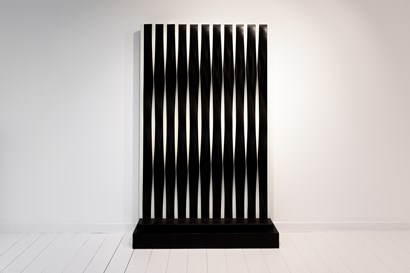
Edouard Simoens Gallery
walter leblanc
Walter Leblanc (Antwerp 1932-1986 Silly) Torsions, 1977-1978 Black and white enamelled steel sculpture 200 x 130 cm Provenance: Walter & Nicole Leblanc Foundation; private collection; André Simoens Collection Literature: Linea Catalogue raisonné, 1997, Ludion, Brussels, CR 1271, p. 282 Exhibitions: Brussels, Tecno, Walter Leblanc Integratie, 1983; Gent, Floraliapaleis, Linea ’83, 1983
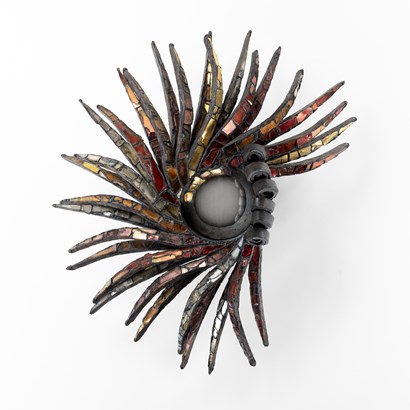
unforget Decorative Arts
line vautrin
Line Vautrin (Paris, 1913-1997) Crète de coq mirror, circa 1965 Talosel inlaid with mirror fragments H 50 x W 41.5 cm Diameter at sight of the central witch: 10 cm This work is accompanied by a certificate of authenticity issued by the Line Vautrin Committee “Crète de Coq”, mirror in black Talosel inlaid with mirror fragments, by Line Vautrin. This convex “witch mirror” features a radiant decoration of incised Talosel inlaid with polychrome mirror tesserae in shades of red, gold, copper, and silver. The spiral composition evokes the bristling energy and dynamic movement of a cockscomb, its form at once organic and architectural. A rare and technically demanding creation, Crète de Coq exemplifies Vautrin’s experimental mastery of Talosel - a material she both discovered and transformed into a medium of pure artistic expression. In this piece, she chose a warm palette of reds, oranges, golden ambers, and bronzed tones, creating a striking contrast with the deep black of the Talosel structure. The frame itself unfolds in six spiraling curves, each extending into a series of radiant, gently curved points that seem to shimmer and vibrate with light. Singular within her oeuvre, this asymmetrical spiral composition differs from Vautrin’s more familiar series, revealing her ability to reinvent form and rhythm through subtle variations. Crète de Coq is not merely a mirror, but a luminous, poetic sculpture - an enchanting testament to Line Vautrin’s imagination and her genius for turning humble materials into magical, living art.
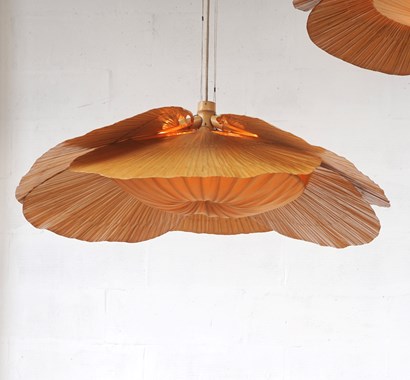
Maisonjaune Studio
ingo maurer
Ingo Maurer (Germany, 1932-2019) Hana Chandelier (Uchiwa collection), 1970s Bamboo, Japanese paper Provenance: Japan The Hana chandelier belongs to Ingo Maurer’s Uchiwa collection, created in the 1970s. Handmade in Japan from bamboo and Japanese paper fans, it radiates lightness and poetry. Its sculptural presence blends tradition with refined modernity. Exceptionally rare today, it stands as one of Maurer’s most iconic creations.

Almine Rech
hans op de beeck
Hans Op de Beeck (Turnhout, 1969) Crow, 2025 MDF, metal, polyamide, coating and bronze H 160 x W 80 x D 56 cm - Weight 39 kg Edition of 5 plus 2 APs Provenance: Studio of the Artist 'Crow' is a kinetic sculpture of a life-size flying crow. Powered by a mechanical system, the crow's flight creates the illusion of forward motion, although it remains suspended in place. 'Crow' evokes the world of fables and classic animated films, in which animals take on human traits. The work also alludes to the age-old tradition of mechanically animated figures, whose repetitive, joyless movements often inspire a quiet melancholy. At the same time, it is striking how lifelike and fluid such mechanically simplified movements can sometimes appear.

Stéphane Renard Fine Art
Workshop of Benedetto da Maiano (Maiano 1442-1497 Florence) Bas-relief of the Virgin and Child with Saint John the Baptist as a child Polychrome and gilded stucco in its original carved and gilded wooden frame H 76 x W 64 x D 13 cm (framed) Provenance: Coat of arms with the alliance arms of two Florentine families: the Compagni (on the left) and the Tornaquinci (on the right) We can estimate that around thirty copies of this bas-relief were probably made, half of which are in public collections (including the Bode Museum in Berlin (Germany – Inv. 1581), the Victoria & Albert Museum in London (United Kingdom – two copies), the Bargello and Stefano Bardini Museums in Florence (Italy), and the Hermitage Museum in Saint Petersburg (Russia) but this one is the only one bearing the coat of arms of its commissioners.
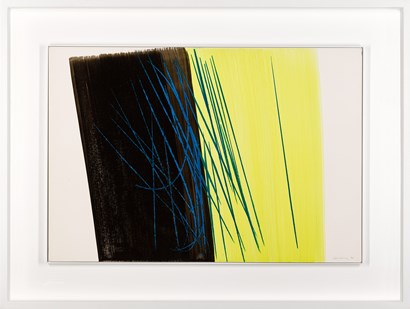
Samuel Vanhoegaerden Gallery
Hans Hartung (Leipzig 1904-1989 Antibes) P1971-20, 1971 Crayon and acrylic on baryta board 50 x 73 cm Signed and dated lower right This work is registered in The Hans Hartung and Anna-Eva Bergman Foundation archive with number P1971-20 and will be included in the forthcoming catalogue raisonné of Hans Hartung Provenance: Galerie Ludorff, Germany; Sotheby's London, July 2020; private Collection, Brussels; acquired from the above by the present owner
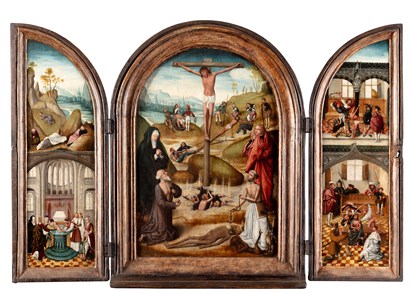
Jan Muller Antiques
Netherlandish School, circa 1500 Triptych with the Crucifixion and scenes from the Passion Oil on panel 51 x 36.5 cm (closed) 51 x 73 cm (open) The gallery is grateful to Dr. Didier Martens for his expertise The Crucifixion with Saint Jerome and Saint Dominic and Scenes from the Passion, Original frame. This triptych depicts Christ on the Cross, flanked by the sorrowful figures of the Virgin Mary and Saint John the Evangelist. Kneeling at the foot of the Cross are Saint Jerome and Saint Dominic, the latter holding a rosary. In the landscape beyond unfold several scenes from Christ’s Passion, culminating in the Crucifixion. This version follows the composition preserved in the Scottish National Gallery, Edinburgh, which originally formed one half of a diptych. Its companion panel, depicting The Coronation of the Virgin, is held in the Museum Boijmans Van Beuningen, Rotterdam. The distinctive iconography is closely associated with the Dominican devotion to the Rosary. Surrounding the central Crucifixion are smaller narrative scenes illustrating key moments from the Passion of Christ: • Christ in the Garden of Olives: Following the Last Supper, Christ withdraws to the Garden of Gethsemane on the Mount of Olives. In deep anguish, he prays to be spared his suffering, while ultimately submitting to God’s will. • The Circumcision: According to the Gospel of Luke, this event occurred eight days after Christ’s birth, during the Brit Milah ceremony at which he received his name. • The Flagellation: This scene depicts the scourging ordered by Pontius Pilate, the customary prelude to crucifixion under Roman law. • Christ on the Cold Stone: The pensive Christ sits, crowned with thorns and bearing the marks of his scourging, his head resting in contemplation. This image reflects the influence of the Devotio Moderna, a movement that emphasized Christ’s human suffering as a model for personal devotion.

